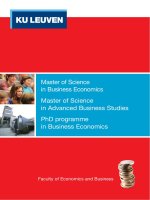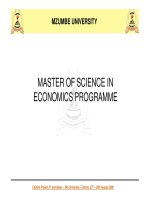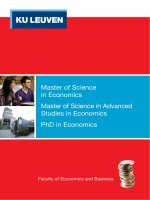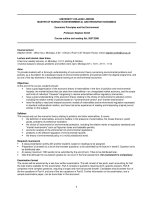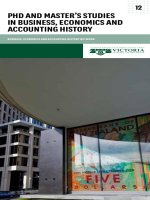Master of Arts in Responsible Management and Sustainable Economic Development pptx
Bạn đang xem bản rút gọn của tài liệu. Xem và tải ngay bản đầy đủ của tài liệu tại đây (1.07 MB, 218 trang )
Master of Arts in Responsible Management and Sustainable Economic Development
Curriculum Development
Omona Frank
Sustainable Development
July 2011
Abstract
This research report is submitted in partial fulfillment of the requirements for the degree
of Master of Arts in Responsible Management and Sustainable Economic Development
The establishment of the Institute of Peace and Strategic Studies of Gulu University in
2003 has necessitated the introduction of more academic programs to meet the increasing
enrollment rate of students. This can only be achieved through the development of more
curricula to meet the demand. The University for Peace, in her Africa program of capacity co-
operation in the Great Lakes region, has entered into a memorandum of understanding with
Gulu University for fellows to undertake the task of developing new academic programs to be
implemented at the Gulu University. This course of Sustainable Development is therefore part
of a whole academic program to be implemented at the Bachelor degree level. The Bachelor
of Arts degree in Peace and Conflict Studies contains at least thirty-five course units to be
covered in six semesters within three years, including this course of Sustainable Development
leading to the award of a Bachelor of Arts Degree. The author used desk top research,
employing the resources at the University for Peace Library and internet sources to develop
the curriculum, coupled with rigorous supervision and guidance of qualified professors in the
fields of Sustainable Development and curriculum design. The method of conducting this
course will be mainly student-centered as will be seen in the lesson plan. This course is made
up of sixty contact hours with thirty sessions of two hours each to be covered in fifteen weeks
of lecture. Topics to be covered will include, among others: Sustainability Principles,
International and National Policies on Sustainability, Sustainability and Green Economy
Agenda, the Private Sector and Sustainability, and Towards Security and Sustainable
Development.
ii
LIST OF ABBREVIATIONS/ ACCRONYMS
BAPCS……………………………………… ….Bachelor of Arts in Peace and Conflict Studies
CO2…………………………………………….…… ………………………… Carbon dioxide
DA……………………………………………………… ………………. Dimension of Analysis
EC ……………………………………………….………………………………… Earth Charter
EU……………………………………………….……………………………… European Union
FAO……………………………………………….………… Food and Agricultural Organization
FBDS…………………………………………. … Faculty of Business and Development Studies
GATT …………………………………………… General Agreement on Tariffs and Trade
GDP…………………………………………….……………………… Gross Domestic Product
GE……………………………………………………………………………… Green Economy
GLP ………………………………………………………. ………… …… Great Lakes Program
GNP…………………………………………………………………….… Gross National Product
GRI……………………………………………………………… …. Global Reporting Initiative
HIV/AIDS……………… Human Immune Virus/Acquired Immune Deficiency Syndrome
ICLEI……………………… …… …. International Council for Local Environmental Initiatives
IDGs………………………….………………………………… International Development Goals
IICA………………………………… Inter-American Institute for Cooperation on Agriculture
IISD……………………………………… International Institute for Sustainable Development
IMF…………………………….……………… …………………. International Monetary Fund
IPSS…………………………….…………………….… Institute of Peace and Strategic Studies
ISO……………………………………………………… International Standards Organization
iii
LDCs…………………………….…………………………… …… Least Developed Countries
MDGs…………………………………………………………….Millennium Development Goals
MNCs……………………………………………………………… Multi-National Corporations
NCHE…………………………….…………………… National Council for Higher Education
OECD………………………… …. Organization for Economic Co-operation and Development
OPEC……………………………… ………………… Oil and Petroleum Exporting Countries
PCS…………………………….……… …………….……………… Peace and Conflict Studies
PPPs………………………………………… ………………………. Public-Private Partnership
SD………………………………………………… …………………. Sustainable Development
TNS……………………………………………………………………………… The Natural Step
TPOs…………………………….……………………………… Trade Promotion Organizations
UA……………………………….……………………………… …………… Unit of Analysis
UACE………………………………………… …… Uganda Advanced Certificate of Education
UN………………………………………………………………………………… United Nations
UNCED………………………… United Nations Conference on Environment and Development
UNDP………………………………………………….… United Nations Development Program
UNEP…………………………………………………… United Nations Environmental Program
WCED…………………………… …… World Commission on Environment and Development
WCU………………………………………………………………… World Conservation Union
WLF……………………………….……… ………………………………… World Life Fund
WSSD……………………………….………… … World Summit on Sustainable Development
WTO………………………………….…………… ……………… World Trade Organization
iv
v
TABLE OF CONTENTS
ABSTRACT……………………………………………………………………………….………i
DECLARATION OF ACADEMIC HONESTY………………………………………………….ii
PERMISSION……… ………………………………………………………………………….iii
LIST OF ABBREVIATIONS/ACCRONYMS………………………………………………… iv
TABLE OF CONTENTS…………………………………………………………………………vi
1.0 GENERAL OR ACADEMIC CHAPTER (CHAPTER ONE)……………………………… 1
1.1 Introduction……………………………………………………………………………1
1.2 Course Description…………………………………………………………………….3
1.3 Main Goal …………………………………………………………………………….4
1.4 General Objectives…………………………………………………………………….4
1.5 Indented Intended Learning
Outcomes………………………………………………………….5
2.0 DETAILED CONTENT (CHAPTER TWO) ……………………………………………… 6
2.1 Detailed content……………………………………………………………………….6
2.2 Method of delivery………………………………………………………………… 20
2.3 Assessment……………….………………………………………………………… 21
3.0 ADMINISTRATIVE CHAPTER (CHAPTER THREE)……………………………… ….22
3.1 Specific course title……………………………………………………………… …22
3.2 Course code……………………………………………………………………… 22
3.3 Pre-requisites ………………………………………………………………… …….22
3.4 Course length…………………………………………………………………… ….22
3.5 Credits…………………………………………………………………………… 23
3.6 Course meeting times and place……………………………………………… ……23
vi
3.7 Intended participants ………………………………………………………… ……23
3.8 Admission Requirements……………………………………………………… … 23
3.8.1 Ugandan Advanced Certificate of Education (U.A.C.E)
Holders………………………………………………………………………… …24
3.8.2 Direct Entry Scheme ……………………………………………… ………24
3.8.3 Mature Age Entry Scheme …………………………………………… ……24
3.8.4 Diploma Holders’ Entry Scheme………………………………………….…24
3.8.5 Direct Entry Scheme………………………………………………… …….24
3.8.6 Mature Age Entry Scheme ………………………………………… ………24
3.8.7 Diploma Holders’ Entry Scheme………………………………………….…24
3.8.8 Note…………………………………………………………………….…….25
3.8.9 Where the course fits within the general program of Studies……….……….25
3.8.10 Evaluation……………………………………………………………… …25
3.8.11 Instructor’s biography………………………………………………… ….26
4.0 TEACHER’S MANUAL (CHAPTER FOUR)…………………………………….……….28
4.1 SESSION 1 …………………………………………………………………….……28
4.1.1 Understanding Sustainable development………………………………… 28
4.2 SESSION 2 ……………………………………………………………………… 34
4.2.1 Envisioning a Sustainable Society ……………………………………… 34
4.3 SESSION 3………………………………………………………………… 40
4.3.1 Sustainability Principles Part I – Respect and Care for the Community of
Life……………………………………………………………………………….40
4.4 SESSION 4……………………………………………………… …………………46
4.4.1 Sustainability Principles Part 2 –Ecological Integrity…………… ……….46
vii
4.5 SESSION 5………………………………………………………………………… 52
4.5.1 Sustainability Principles Part 3 – Social and Economic Justice……………52
4.6 SESSION 6……………………………………………… …………………………58
4.6.1 International policies on sustainability…………………………… ………58
4.7 SESSION 7………………………………………………………………………… 64
4.7.1 National and Local Policies on Sustainability…………………… ……….64
4.8 SESSION 8 ………………………………………………………………………….70
4.8.1 Sustainability and Green Economy Agenda ………………………………70
4.9 SESSION 9……………………………………………………………….………….75
4.9.1 Private Sector and sustainability I…………………………… …….75
4.10 SESSION 10……………………………………………………………… ………81
4.10.1 Private Sector and sustainability II……………………………….……….81
4.11 SESSION 11…………………………………………………………………… …86
4.11.1 Sustainable Development Tools…………………………………… ……86
4.12 SESSION 12…………………………………………… …………………………91
4.12.1 The Biogram ……………………………………………………… …….91
4.13 SESSION 13………………………………………………………………… ……97
4.13.1 The integrated sustainable development index………………….……… 97
4.14 SESSION 14……………………………………………………………….… …103
4.14.1 Temporal observations; Indicators; Maximum and minimum levels;
indices……………………………………………………………….………… 103
4.15 SESSION 15………………………………………………………………………109
4.15.1 Globalization; International economic order………………………….…109
4.16 SESSION 16………………………………………………………………………114
4.16.1 International trade and Development; Theory and practice…… ………114
viii
4.17 SESSION 17 ………………………………………………… ………………….119
4.17.1 International trade and development, Import substitution. …………… 119
4.18 SESSION 18…………………………… ……………………………………….125
4.18.1 Export promotion and Economic integration ………………… ……….125
4.19 SESSION 19……………………………………………………….………… ….130
4.19.1 International finance and debts………………….………………………130
4.20 SESSION 20………………………………………………… ………………….135
4.20.1 Market reform for sustainable Development………………………… 135
4.21 SESSION 21………………………………………………………………………141
4.21.1 Recognizing sustainable Development I……………………………… 141
4.22 SESSION 22………………………………………………………… ………….147
4.22.1 Recognizing sustainable Development II………… ……………………147
4.23 SESSION 23………………………………………………………………………153
4.23.1 Recognizing sustainable Development III………………………………153
4.24 SESSION 24………………………………………………………………………159
4.24.1 Investing in sustainable development I (Invest in people, innovation, and
institutions)……………………………………………….………… …………159
4.25 SESSION 25………………………………………………………………………165
4.25.1 Investing in sustainable development II (Invest in communication and
partnership)………………………………………………………… …………165
4.26 SESSION 26………………………………………………………………………171
4.26.1 Investing in sustainable development III (Invest in a supporting
environment and imitation)…………………………………………………… 171
4.27 SESSION 27………………………………………………………………………177
ix
4.27.1 Dimensions of sustainable Development I (Social and Political –
institutional dimensions)……………………………………………………… 177
4.28 SESSION 28………………………………………………………………………183
4.28.1 Dimension of sustainable Development II (Economic and Environmental
dimension)………………………………………………………………………183
4.29 SESSION 29………………………………………………………………………189
4.29.1 Peace, security, development, and the environment…………………….189
4.30 SESSION 30………………………………………………………………………195
4.30.1 Towards security and sustainable development (principles)…………….195
BIBLIOGRAPHY………………………………………………………………………………201
1
1.0 GENERAL OR ACADEMIC CHAPTER (CHAPTER ONE)
1.1 Introduction:
This course is just one unit in a whole academic program that is also being
developed at the same time. The bachelor degree program (Bachelor of Arts in Peace
and Conflict Studies) is to be implemented at the Institute of Peace and Strategic
Studies (IPSS) of Gulu University. Contextually, the course relates to the real
conditions on the ground since Northern Uganda, in particular, has been ravaged by
armed conflict for over two decades. The government of Uganda, with the help of
international organizations, is currently trying to repatriate people from the internally
displaced people’s camps back to their villages. These individuals need a source of
livelihood since the government will not be able to support them forever. One of the
ways this can come about is through the invaluable means of education. This course
of Sustainable Development has education as one of its key objectives, as will be
outlined later. The people of Uganda, as one of the developing countries, and
Northern Uganda in particular need the knowledge and skills of sustainable
development. This course, then, finds real meaning in solving a problem that exists on
the ground.
The field of Peace and Conflict Studies is a new one that is attracting a lot of
international attention, and this course, being a unit in an academic program that is
directly under the field of Peace and Conflict Studies, will certainly be received well
at the University. Uganda lies within the Great Lakes Region of Africa, and peace and
security issues are a regional concern in this region. This again underscores the
rationale of developing this course within the academic program to be implemented at
Gulu University.
Many books by researchers in the field of Peace and Conflict Studies present
the view that students who study the subject become more peaceful and their attitudes
towards peace change for the better. For example, in their book entitled The Promises
2
and Pitfalls of Peace Education Evaluation, Lin, Brantmeier, and Bruhn had this to
say, quoting Bickmore (2002) and Johnson & Johnson (1996): “conflict resolution
programs in schools have improved the capacity of students to handle conflict
peacefully, their relationship with peers and attachment to school” (2008, p. 251).
This proves that Peace and Conflict Studies can have a positive impact on the
students. It then remains the responsibility of the peace educator to be effective in the
delivery of knowledge in such a way that will have an impact on the students. In most
cases, violence in schools committed by students reflects the violence that is taking
place in the society at large, and it becomes the responsibility of peace educators to
ensure that the students go back home with a different perspective on peace. Peace
educators should evaluate their students before and after the study of Peace and
Conflict Studies in order to be able to determine the impact of the studies on the
students. The current world order of escalating violence, even in the form of
terrorism, underscores the need to have in place proper educational programs in the
field of Peace and Conflict Studies in the form of curricula that have to be
implemented in formal educational systems.
As mentioned earlier, the specific condition in Uganda and in Northern
Uganda in particular, where this course will be implemented, is the recovery from
war. The people of Northern Uganda need sustainable development skills so as to
recover from the trauma of the rebel activity of Joseph Kony that ravaged the North of
the country for over twenty years. At all levels, from international to national, the
design of this course and the whole academic program of Peace and Conflict Studies
are fully justified. Uganda as a country has recently been ravaged by rebel activities
which increased the level of conflict and violence in the country. Notable is the
rebellion of the Lord’s Resistance Army (LRA), which affected particularly the north
of the country for at least two decades. Other areas affected include eastern districts
such as Teso land and the northwestern districts of Arua and Moyo. The activity of
3
another rebel group (Allied Democratic Front-ADF) in the south of the country also
terrified the southern districts. This is evidence that, just as in other parts of the world,
Uganda needs transformation in the form of Peace and Conflict Studies so that peace
can be restored in many parts of the country.
The need for the above is expressed in the following report by the British
Broadcasting Corporation (BBC), published in the year 1999: “A Ugandan non-
governmental organization has launched a peace education syllabus, with the aim of
seeing it introduced to school children of all ages. Topics in the syllabus include
learning respect for others, conflict resolution and neighborliness”.
More than basic needs, the situation in Northern Uganda requires skills in
handling peace and conflict issues as indicated above, and this has to be done
effectively such that it can impact the lives of the recipients. This will help develop a
culture of tolerance and promote development.
Coming down to the University level, this course fits within the six strategic
plans of the University, which includes developing new academic programs. The
University recently opened the Institute of Peace and Strategic Studies (IPSS) in
2007, which now offers two masters programs, but badly needs a bachelor degree
program. This will help create a network of peace builders from the lower level, as
will be discussed in the objectives section of this course curriculum.
1.2 Course Description
Sustainable development is a characteristic aspect of any peaceful society. In
developing an academic program such as Peace and Conflict Studies, it would be
almost inevitable to include this course. Secondly, this course was jointly agreed upon
by two other senior faculty members in the earlier stage of the curriculum
development process in August of 2011. This took place at the second curriculum
development workshop organized by the University for Peace Africa program (GLP).
The point here is that the course has a strong foundation and higher chance of being
4
accepted by the management of the University once presented to them for
implementation. The course will then contribute to addressing the issue of providing
people with sustainable development skills at the country level and, by extension, at
other higher levels.
1.3 Main Goal
The main goal of this course is for community transformation. This goal is in line
with the six strategic plans of Gulu University and the standards of the National
Council of Higher Education in Uganda (NCHE). At the same time, the Institute of
Peace and Strategic Studies (IPSS) intends to develop new academic programs in the
field of Peace and Conflict Studies to address the need for community transformation,
which is also the overall goal of Gulu University. This course will then be part of the
effort to achieve that main goal of community transformation by providing knowledge
and transferable skills in sustainable development.
One of the visions of Gulu University in its strategic plan is to be a leading academic
institution for the promotion of rural transformation and industrialization for
sustainable development. This course will work to help fulfill that goal.
Globally, this course will focus on the complexities of today's global challenges, such
as the impacts of globalization, financial and political crises, and climate change on
sustainable development and, more specifically, war-torn societies.
1.4 General Objectives:
The course of Sustainable Development to be implemented at Gulu University
shall provide theoretical and practical training for students in a wide range of careers
in the field of Peace and Conflict Studies since it is part of a bigger curriculum.
However, this course will have a bias towards sustainable development skills such as
entrepreneurship.
5
The course will explore the concepts, procedures and reasoning underpinning
the Ugandan National Policy for Higher Education while acknowledging the
importance of international systems as impacting community transformation through
sustainable development.
The general objectives of this course can then be summarized as follows:
To enable students to have a strong background in the field of Sustainable
Development from the lower levels of education and not necessarily the
masters level.
To equip students with relevant skills for sustainable development practices and
to be able work in diverse fields while contributing to transformation of their
communities through the pursuit of sustainable development.
To contribute to the national objective of literacy and building a pool of trained
individuals who can contribute positively to national and international
development.
As part of the main program of Bachelor of Arts in Peace and Conflict
Studies, this course will provide not only knowledge and skills, but also values
such as the spirit of team building and togetherness.
1.5 Indented Intended Learning Outcomes:
The following learning outcomes will be evident in the students at the end of
this course. The learners will be able to reliably demonstrate the ability to:
Explain the various concepts and theories behind sustainable development.
Engage in and manage sustainable development activities at a personal level,
such as small business enterprises.
Fully and freely participate in community activities related to sustainable
development.
Carry out applied research in the field of Sustainable Development.
6
Effectively participate in conflict resolution and mediation processes
7
2.0 DETAILED CONTENT (CHAPTER TWO)
Below is a table of the detailed content of the topics and the sub-topics to be
covered during the course. The readings recommended can be expanded as more
resources become available. A general bibliography is included at the end of this
document.
2.1 Table of detailed content
WEEK 1
SESSION 1
Understanding Sustainable Development
READINGS 1
Speth, J. G. (2004). Red Sky at the Morning. New Haven: Yale University Press, p.
150 – 171.
The World Commission on Environment and Development. (1987). Our Common
Future. Oxford: Oxford University Press, p. 1-17.
RECOMMENDED READINGS
Mansoor, D. (2007). Global Development Finance: The Globalization of Corporate
Finance in Developing Countries. Washington D.C.: World Bank, p. 35-62.
SESSION 2
Envisioning a Sustainable Future
READINGS 2
The World Commission on Environment and Development. (1987). Our Common
Future. Oxford: Oxford University Press, p.43– 49.
Edwards, A. R. (2006). The Sustainability Revolution. Philadelphia: New Society
Publishers, p. 1- 27.
RECOMMENDED READINGS
Milbrath, L. W. (1989). Envisioning a Sustainable Society: Learning our Way Out.
Albany: State University of New York Press, p. 197- 218.
WEEK 2
8
SESSION 3
Sustainability Principles Part I (Respect and care for the community of life)
READINGS 3
Boff, L. (2008). The Ethic of Care. In P. B. Corcoran & A.J. Wohlpart (Eds.), A Voice
for Earth: American Writers Respond to the Earth Charter. Athens:
University of Georgia Press, p. 129-145.
Singer, P. (2006). Practical Ethics. New York, NY: Cambridge University Press, p.
264-288.
RECOMMENDED READINGS
Preston, N. (2001). Understanding Ethics. Sydney: The Federation Press, p.186-203.
SESSION 4
Sustainability Principles Part II (Ecological integrity)
READINGS 4
Mackey, B. G. (2004). The Earth Charter and Ecological Integrity – Some Policy
Implications. In World Views: Environment, Culture, Religion, Vol. 8 No. 1.
Leiden, Netherlands: Brill Academic Publishers. p, 76-92.
Speth, J. G. (2008). The Bridge at the Edge of the World: Capitalism, the
Environment, and Crossing from Crisis to Sustainability. New Haven: Yale
University Press, p.147-164.
RECOMMENDED READINGS
Woodley, S., Kay, J., & Francis, G. (1993). Ecological Integrity and the Management
of Ecosystems. Delray Beach, Florida: St. Lucie Press, p. 55-119.
WEEK 3
SESSION 5
Sustainability principles part III (Social and economic justice)
READINGS 5
Brown, P., & Garver, G. (2009). Right Relationships; Building a Whole Earth
Economy. San Francisco: Berrett-Koehler Publishers, Inc., p. 1-21.
9
Gustave, S. P. (2008). The Bridge at the Edge of the World: Capitalism, the
Environment, and Crossing from Crisis to Sustainability. New Haven: Yale
University Press, p.126-146.
RECOMMENDED READINGS
Singer, P. (2006). Practical Ethics. New York, NY: Cambridge University Press, p.
218-246.
SESSION 6
International policies on sustainability
READINGS 6
United Nations. (1992). Agenda 21. UN Conference on Environment and
Development, Rio de Janeiro, Brazil.
International Institute for Sustainable Development. (2002). Ten+Ten Sustainable
Development Successes and Failures.
RECOMMENDED READINGS
United Nations. (2002). The Road from Johannesburg: What was achieved and the
way forward.
WEEK 4
SESSION 7
National and local policies on Sustainability
READINGS 7
Organization for Economic Co-operation and Development. (2001). Strategies for
Sustainable Development: Practical Guidance for Development Co-operation.
Paris: OECD, p. 7 – 13; 17- 22; 24 – 26.
Swedish Government. (2002). Sweden’s National Strategy for Sustainable
Development.
RECOMMENDED READINGS
10
International Council for Local Environmental Initiatives. (1996). The Local Agenda
21 Planning Guide. London: EarthScan Publications, p. 1-11.
SESSION 8
Sustainability and Green Economy Agenda
READINGS 8
Gustave, S. J. (2008). The Bridge at the End of the World: Capitalism, the
Environment, and Crossing from Crisis to Sustainability. New Haven: Yale
University Press, p. 89 – 106.
United Nations Environment Program. (2011). Green Economy: Driving a Green
Economy through Public Finance and Fiscal Policy Reform.
/>fiscal-reform/
RECOMMENDED READINGS
Danaher, K., Biggs, S., & Mark, J. (2007). Building the Green Economy: Success
Stories from the Grassroots. Sausalito, California: PoliPoint Press, LLC, p.
113-145.
WEEK 5
SESSION 9
Private sector and sustainability I
READINGS 9
Nattrass, B. F., & Altomare, M. (2001). The Natural Step for Business. Canada: New
Society Publishers, p. 3 – 8.
Willard, B. (2002). Sustainability Advantage. Gabriola Island, British Columbia: New
Society Publishers, p. 60 – 63, 139 – 153.
RECOMMENDED READINGS
McDonough, W. J., & Braungart, M. (2002). Cradle to Cradle: Remaking the Way we
Make Things. New York, NY: North Point Press, p. 45-82
SESSION 10
11
Private sector and sustainability II
READINGS 10
McDonough, W. J., & Braungart, M. (2002). Cradle to Cradle: Remaking the Way we
Make Things. New York, NY: North Point Press, p. 157 - 182.
Nattrass, B. F., & Altomare, M. (2001). The Natural Step for Business. Canada: New
Society Publishers, p. 9 – 29.
RECOMMENDED READINGS
Blewitt, J. (2008). Understanding Sustainable Development. London, UK: EarthScan,
p.138 - 143.
WEEK 6
SESSION 11
Sustainable Development Tools
READINGS 11
Blewitt, J. (2008). Understanding Sustainable Development. London, UK: EarthScan,
p.173-198.
Wakernagel, M., & Rees, W. E. (1996). Our Ecological Footprint: Reducing Human
Impact on the Earth. Gabriola Island, British Columbia: New Society
Publishers, p. 9 – 12.
RECOMMENDED READINGS
Meadows, D. H., Randers, J., & Meadows, D. L. (2004). Limits to growth: The 30-
year Update. White River Junction, Vermont: Chelsea Green Publishing
Company, p. 265 – 284.
SESSION 12
The Biogram
READINGS 12
Lawn, P. A. (2006). Sustainable Development Indicators in Ecological Economics.
Cheltenham: Edward Elgar Publishing Ltd., p. 3-13.
United Nations. (2007). Indicators of Sustainable Development: Guidelines and
12
Methodologies. New York, NY: United Nations Publications, p. 47-60.
RECOMMENDED READINGS
Sepulveda. S., Chavarría, H., & Rojas, P. (2005). Methodology to Determine the Level
of Sustainable Development of Rural Territories. San Jose, Costa Rica: IICA,
p. 18-21.
WEEK 7
SESSION 13
The integrated sustainable development index
READINGS 13
Clive, G., & Kirkpatrick, C. H. (2007). Impact Assessment and Sustainable
Development: European Practice and Experience. Cheltenham: Edward Elgar
Publishing Ltd., p. 15-131.
Kuik, O. (1991). In Search of Indicators of Sustainable Development. Dordrecht,
Kluwer; Netherlands: Springer, p. 107-120.
RECOMMENDED READINGS
Sepulveda. S., Chavarría, H., & Rojas, P. (2005). Methodology to Determine the Level
of Sustainable Development of Rural Territories. San Jose, Costa Rica: IICA,
p. 22-23.
SESSION 14
Temporal observations, indicators, maximum and minimum levels, and indices.
READINGS 14
Dalal-Clayton, D. B., & Bass, S. (2002). Sustainable Development Strategies: A
Resource Book. Sterling, Virginia: EarthScan, p. 74-91.
Inter-American Institute for Co-operation in Agriculture. (2008). IICA’s Contribution
to the Development of Agriculture and Rural Communities in the Americas.
RECOMMENDED READINGS
Sepulveda. S., Chavarría, H., & Rojas, P. (2005). Methodology to Determine the Level
13
of Sustainable Development of Rural Territories. San Jose, Costa Rica: IICA,
p. 23-32.
WEEK 8
SESSION 15
Globalization, international economic order
READINGS 15
Held, D., & McGrew, A. G. (2007). Globalization/Anti-globalization: Beyond the
Great Divide. Cambridge: Polity Press, p. 73-117.
Steger, M. B. (2009). Globalization. Oxford: Oxford University Press, p. 1-21.
RECOMMENDED READINGS
Stiglitz, J. E. (2003). Globalization and its Discontents. New York, NY: W.W.
Norton, p. 11- 67.
SESSION 16
International trade and development: theory and practice
READINGS 16
Ajami, R. A., & Goddard, G. J. (2006). International Business: Theory and Practice.
Armonk, NY: M.E. Sharpe, Inc., p. 3-104.
Roy, K. C., Sen, R. K., & Tisdell, C. A. (1997). World Trade and Development:
Economic Integration, Regional Blocs, and Non- Members. New Delhi:
Atlantic Publishers, p. 11-38.
RECOMMENDED READINGS
Bardhan, P. K. (2003). International Trade, Growth, and Development: Essays.
Malden, Massachusetts: Wiley-Blackwell, p. 7-30.
WEEK 9
SESSION 17
International trade and development: import substitution
READINGS 17
Page, S. (1990). Trade, Finance and Developing Countries: Strategies and
14
Constraints in the 1990s. Savage, Maryland: Barnes & Noble Books, p. 265-
319.
Jovanovic, M. N. (1998). International Economic Integration: Limits and Prospects.
London: Routledge, p. 316- 342.
RECOMMENDED READINGS
McEachern, W. A. (2008). Economics: A Contemporary Introduction. Mason, Ohio:
South-Western Cengage Learning, p. 1-71.
SESSION 18
Export promotion and economic integration
READINGS 18
Page, S. (1990). Trade, Finance and Developing Countries: Strategies and
Constraints in the 1990s. Savage, Maryland: Barnes & Noble Books, p. 319-
332.
Jovanovic, M. N. (1998). International Economic Integration: Limits and Prospects.
London: Routledge, p.342-350.
RECOMMENDED READINGS
McEachern, W. A. (2008). Economics: A Contemporary Introduction. Mason, Ohio:
South-Western Cengage Learning, p. 71-84.
WEEK 10
SESSION 19
International finance and debts
READINGS 19
Cornes, R. & Sandler, T. (1996). The Theory of Externalities, Public Goods, and Club
Goods. Cambridge: Cambridge University Press, p. 3-10, 39-66.
Gordon, R. L. (1994). Regulations and Economic Analysis: A critique over two
Centuries. Boston: Kluwer Academic Publishers, p. 49-57.
RECOMMENDED READINGS


